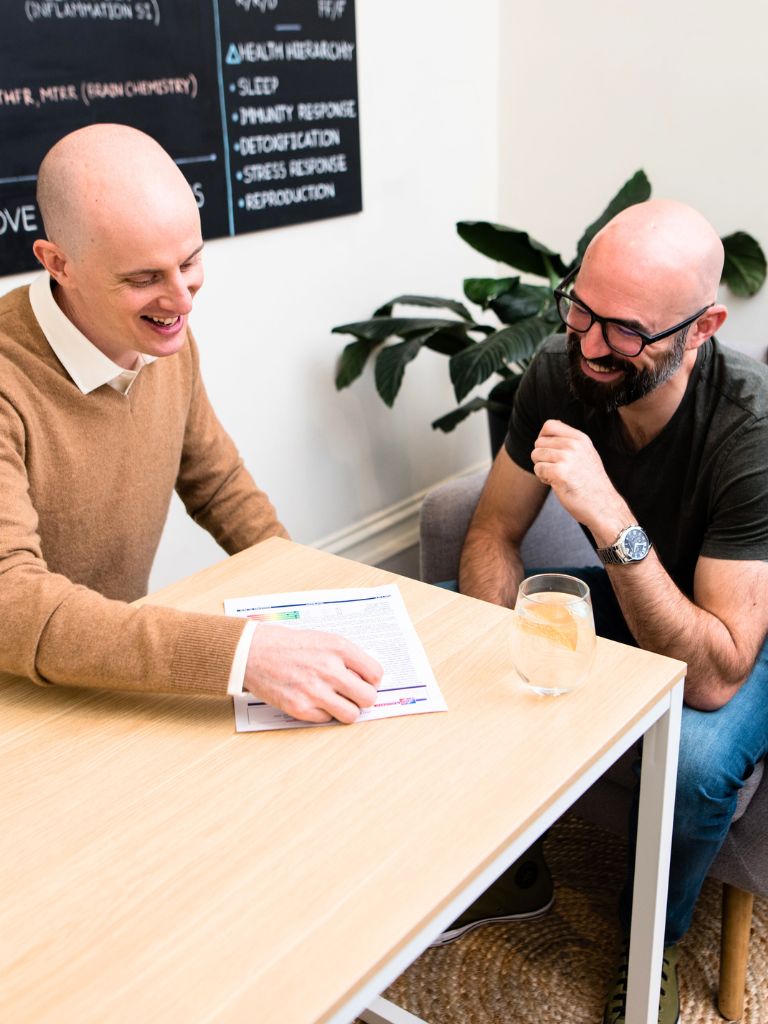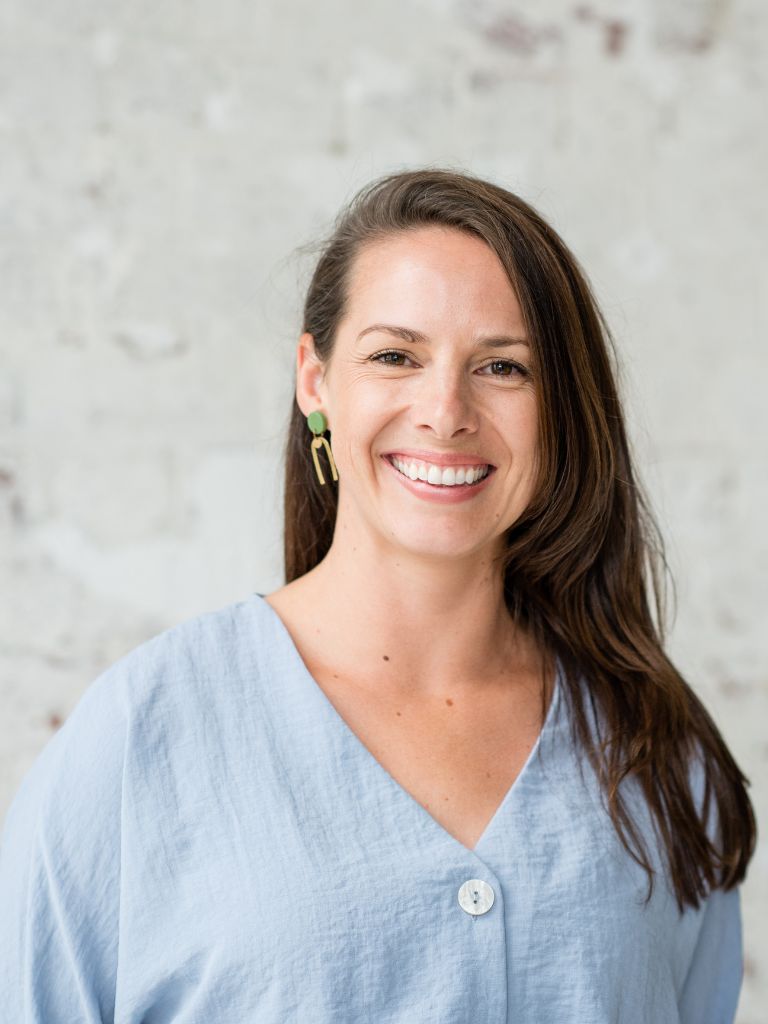A new framework to better understand what’s on offer and how to match it to your needs
So you’ve been listening to Gary Brecka, Peter Attia and Kara Fitzgerald, or even Sara Gottfried, and you are more inspired than ever to start making changes towards a healthier life now, with the promise of a healthy life later.
Some call it lifespan, longevity or healthspan. I like to describe it as health optimisation, which is the ongoing pursuit of living in a body that is functioning in its peak state, at any age. It could be said that what you do to get to peak functioning is as important as having a blueprint or strategy that is personalised to you.
“Health optimisation is the ongoing pursuit of living in a body that is functioning in its peak state, at any age.”
– Liv Brown
There is no doubt about it. Longevity is the buzz topic about town, with scientists beaming into the limelight, achieving near-celebrity status with New York Times best-selling books, skyrocketing YouTube views and venture capitalists scrambling to invest in the next big longevity idea. In fact, leading economic strategists are suggesting that by 2030, there will be double the global investment in longevity and anti-ageing as compared to 2020, which has been fueled by the decade prior, between 2010 and 2020 seeing significant increases in scientific studies and advancement on understanding ageing vectors and the hallmarks of ageing. For now, many of the most prominent voices in this space are based in Europe and the US, leaving a trail of Australian-based followers seeking a local service.
The question you are then left Googling is: “Where do I find a health optimisation service in Australia?” and “How do I know they are credible, good at what they do, and matched to what I am really looking for?”.
Press enter on that and you will be presented with a smattering of longevity medical clinics, longevity centres, health optimisation services, diagnostic screening clinics, gyms, wellness centres, biohacking clinics, medical centres that have named themselves longevity centres, aesthetic skin centres and more.
It’s a minefield!
This article will help you navigate the growing number of health optimisation services on the market, and determine how to choose which service is right for you!
How do I find the right health optimisation service?
The best way to understand what health optimisation service is right for you is to first, zoom right up to 10,000 feet and view the health and longevity market in a simple way. I like to use my simple Health Services Matrix, and then match current needs to one of the quadrants.
Let’s start by splitting the healthcare industry in an oversimplified way, by breaking it down across two axes that create the Health Services Matrix:
- THE HOW: KNOW vs DO: Is the service information-led or experience-led?
- THE WHY: SICK vs OPTIMUM: Is the service focused on being sick or avoiding disease, or is it focused on creating health?
The WHAT of this matrix lives in the detail of each quadrant.

Pathogenesis: How do we manage and prevent disease?
On the left of the vertical axis is pathogenesis, where we ask the question “How do we manage and prevent disease?”. You could say this side of the matrix represents the conventional medical system. Peter Attia describes this as medicine 2.0 and it is a system that is necessary and serves us exceptionally well when we need it for acute health conditions.
We can then divide these services into being information-led – finding out about disease and labelling it with the guidance of a qualified medical professional. And then we can move down to the experiential element of treatment, or if you like, the things you must do to get better, such as taking your medication, changing lifestyle habits or having a medical intervention like surgery.
Let’s list some examples of the services that you may find on the left.
Disease detection services(SICK x KNOW)
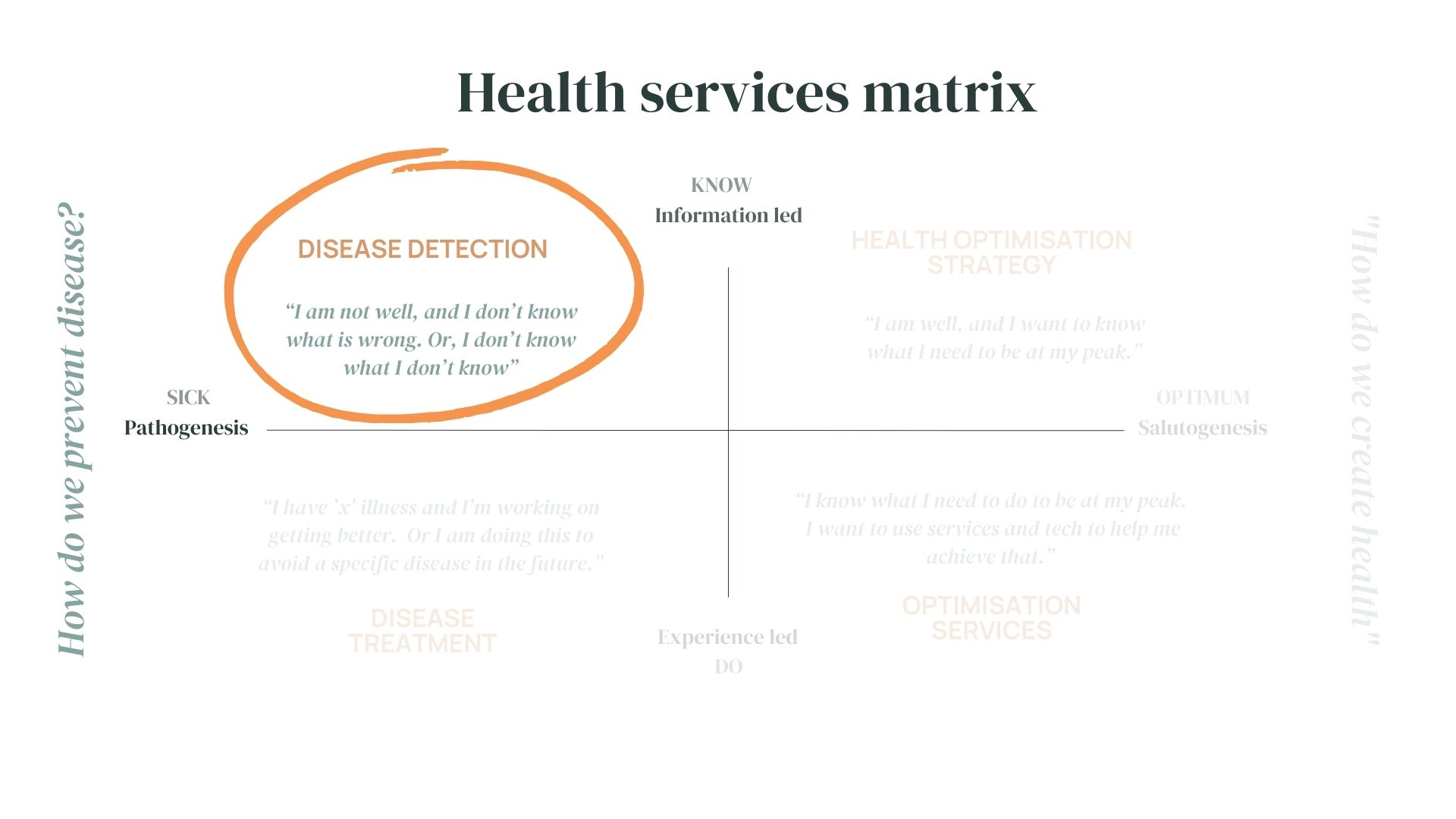

Services may include:
- Your GP
- Medical centres that offer disease prevention and health checks
- Executive health solutions designed to test and tell you your current risk for disease
- Centres with medical grade scans and screening to uncover disease detection
Disease treatment services (SICK x DO)
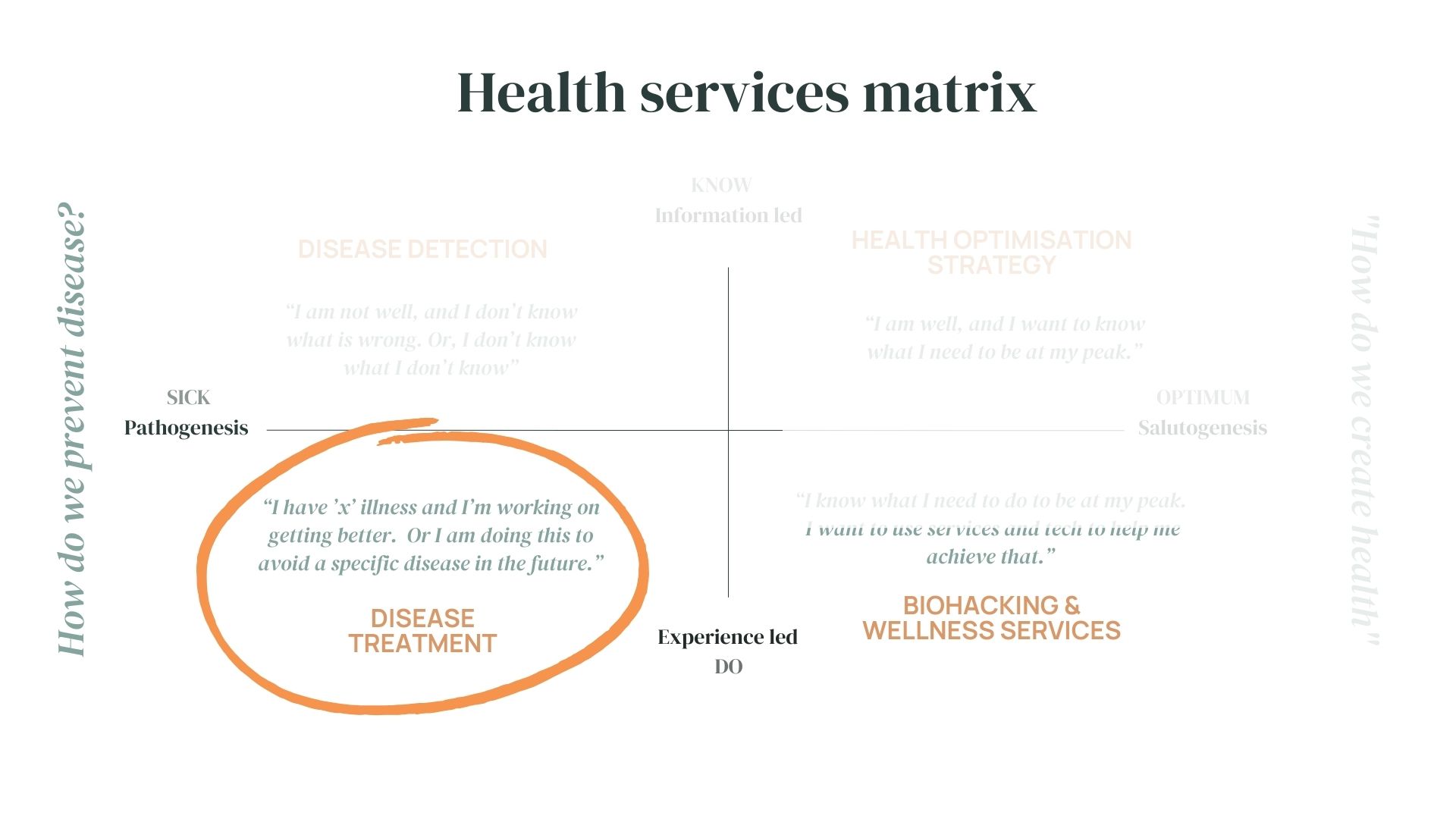
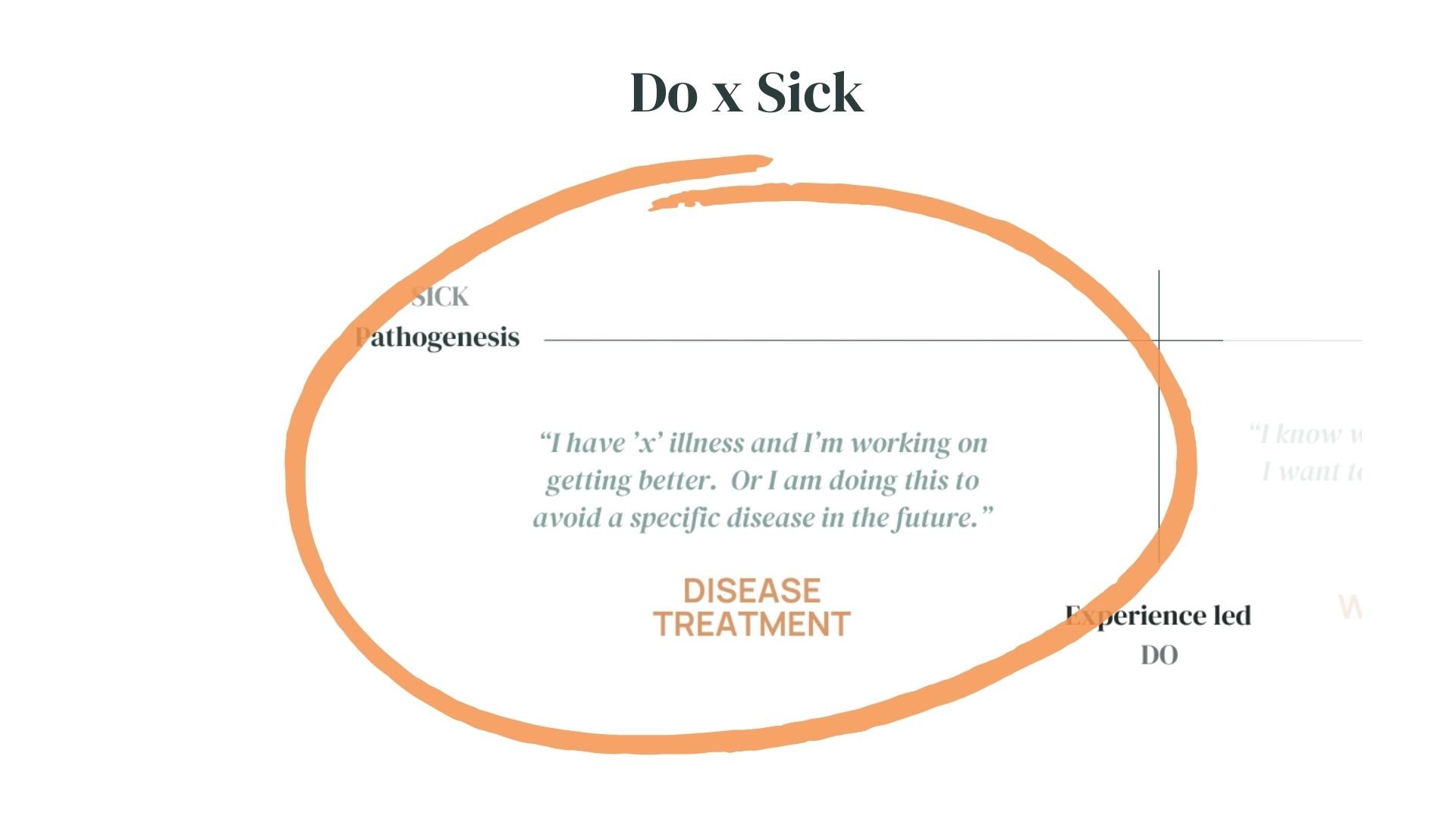
Services may include:
- Surgery
- Hospital
- Diabetes education centres
- Rehabilitation gyms and studios
Salutogenesis: How do we create health and promote longevity?
On the right of the vertical axis is salutogenesis, where we ask the question “How do we create health (and promote longevity)?”. You could say this side of the matrix represents a new world health system. This is closer to what Peter Attia describes as medicine 3.0. Whereas Medicine 2.0, as Attia describes, is allopathic medicine as it is offered today which is evidence-based, and is designed to diagnose and manage disease and acute illness. Medicine 3.0 is evidence-informed, activates early preventative measures and is highly personalised. The principles of Medicine 3.0 and functional medicine overlap.
Within the information-led quadrant of this half, the services are aimed at helping patients understand and access what they need to be at their peak health and performance, now and in the future. It is about accessing clinical guidance and support that is personalised and tailored to you, as the n=1, setting aside assumptions. It helps you answer this question for you only “What do I need to be at my peak?”.
N=1 is a critical aspect of health optimisation strategy. In clinical research, an N (number) of 1 [n=1] means a trial in which a single patient is the sample size.
Because each patient’s genetics, biology and lifestyle are distinct, what works for one person may not work for another. Instead of relying solely on generalised health recommendations or population-level studies, practitioners of “n=1” focus on their unique, individual responses to various interventions, whether they are dietary recommendations, exercise performance, supplements, or other lifestyle modifications.
Once you know what you need to be at your peak, then you ideally can seek out the additional well-being protocols and ‘hacks’ to achieve your optimum that are more experience-led. Examples could be centres that offer red light therapy, mild hyperbaric oxygen therapy (mHBOT), infrared saunas, regular saunas, cryotherapy or pulsed electromagnetic field therapy (PEMF).
Let’s list out some examples of the services that you may find on the right:
Health optimisation strategy (OPTIMUM x KNOW)
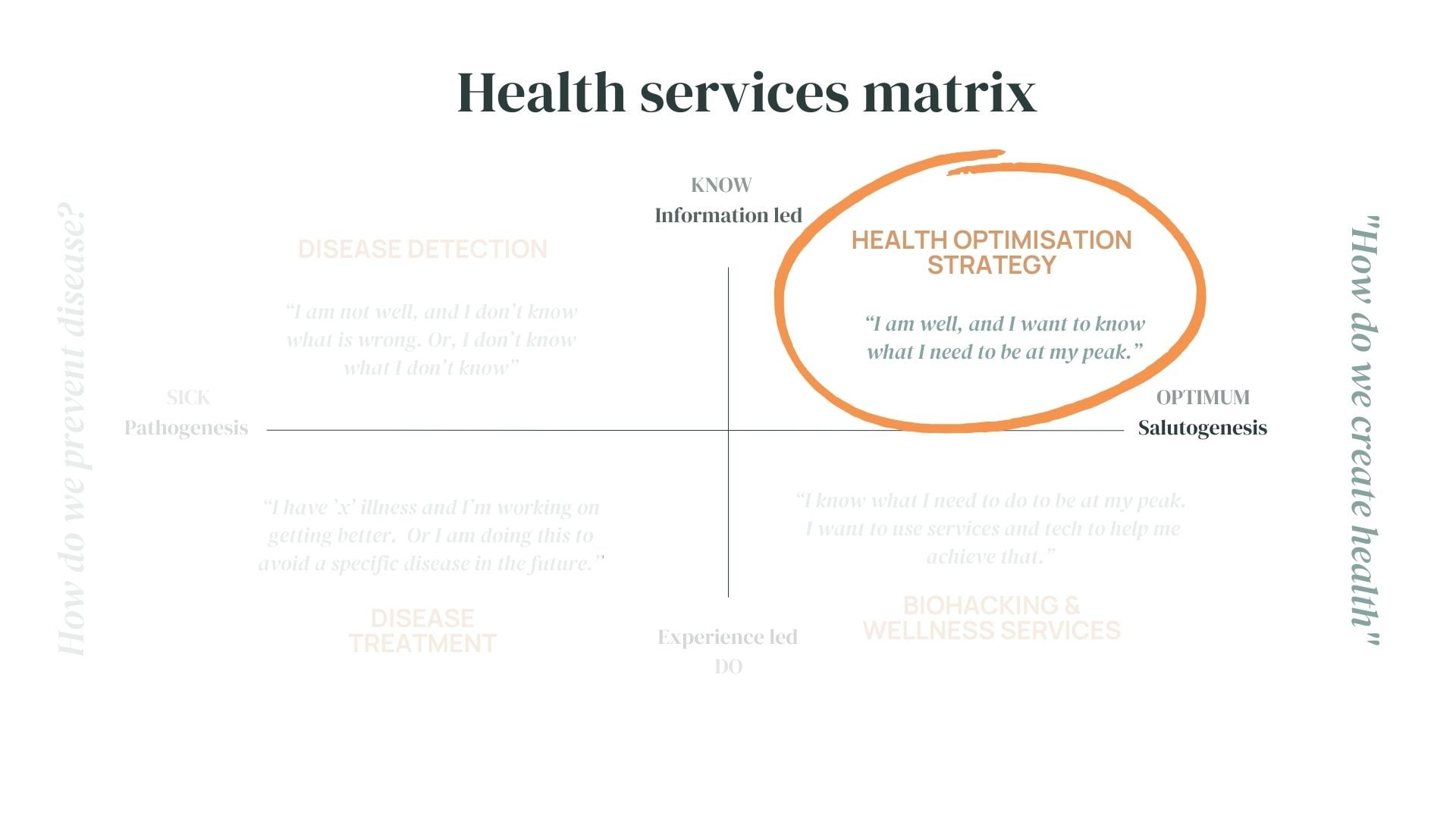
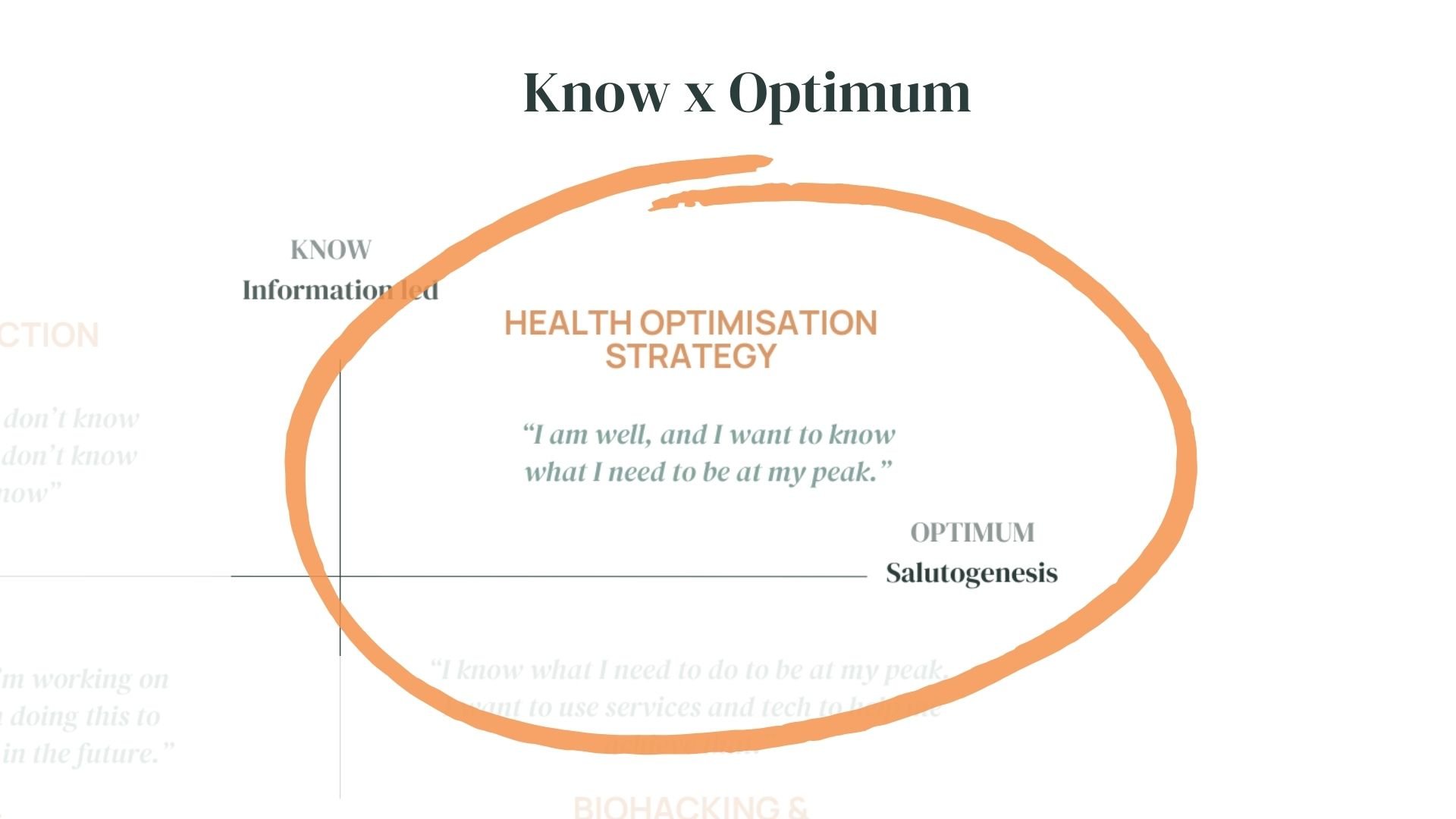
Accessing a human brain for strategy and personalised protocol:
- A GP clinic dedicated to longevity vs disease
- A naturopathy, osteopathic, chiropractic, Chinese medicine clinic dedicated to health optimisation and longevity
- Sports performance services
- Executive health services designed to lift your good level of health to the next level
- Functional medicine clinic dedicated to health optimisation and longevity
These services will be more of a financial investment because you are paying for a human brain to create your health optimisation protocol.
Accessing a computer’s AI brain for strategy and personalised protocol:
- Digital health services designed to give you direction and information from an AI brain to make decisions toward health. Often these will be delivered via an app. For example, in the US there are many e.g. Function Health, Inside Tracker, Levels, etc.
These services will likely be far more cost effective because you are essentially paying less for a computer’s brain to develop a health protocol.
Biohacking and wellness services (OPTIMUM x DO)
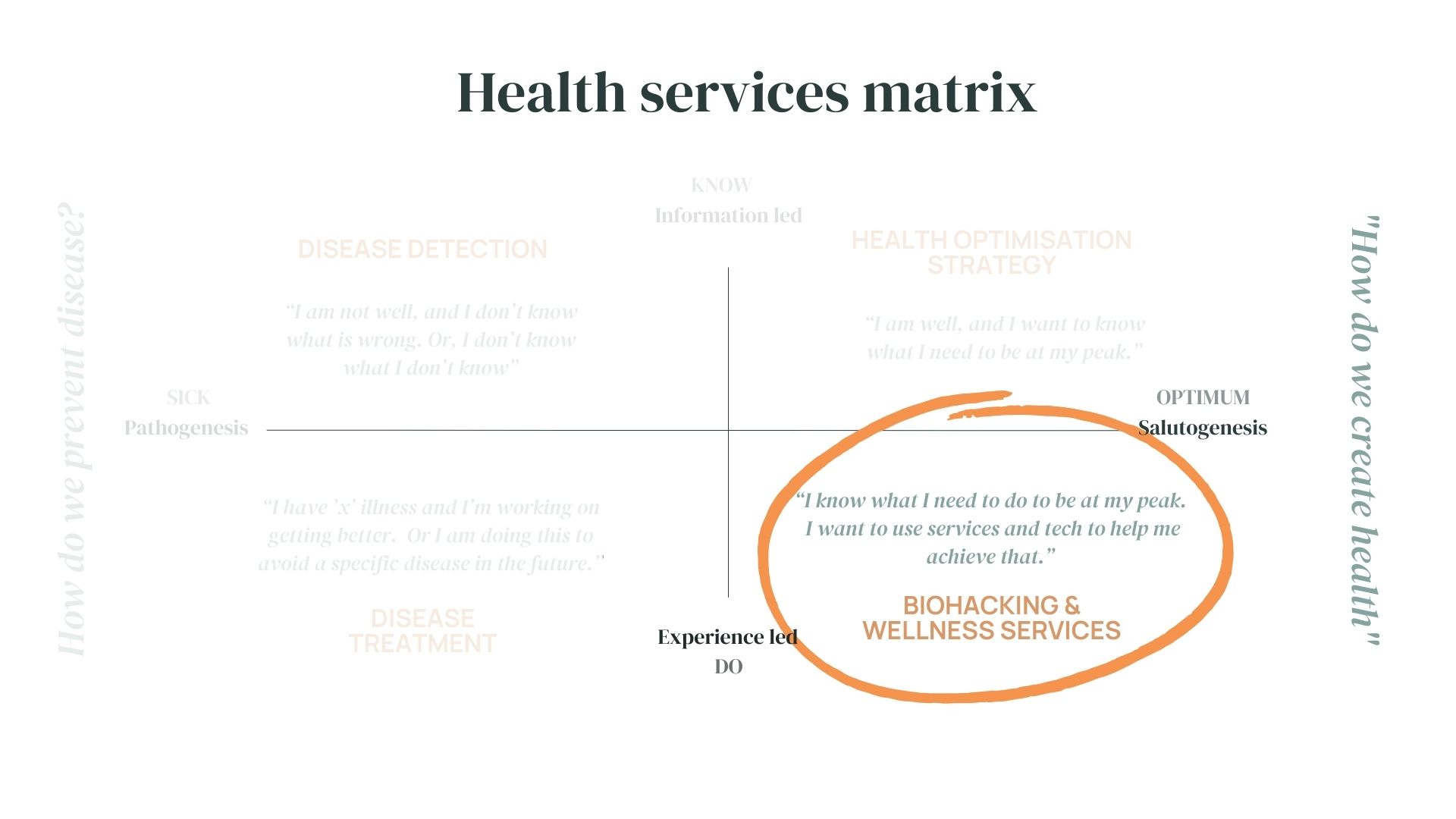
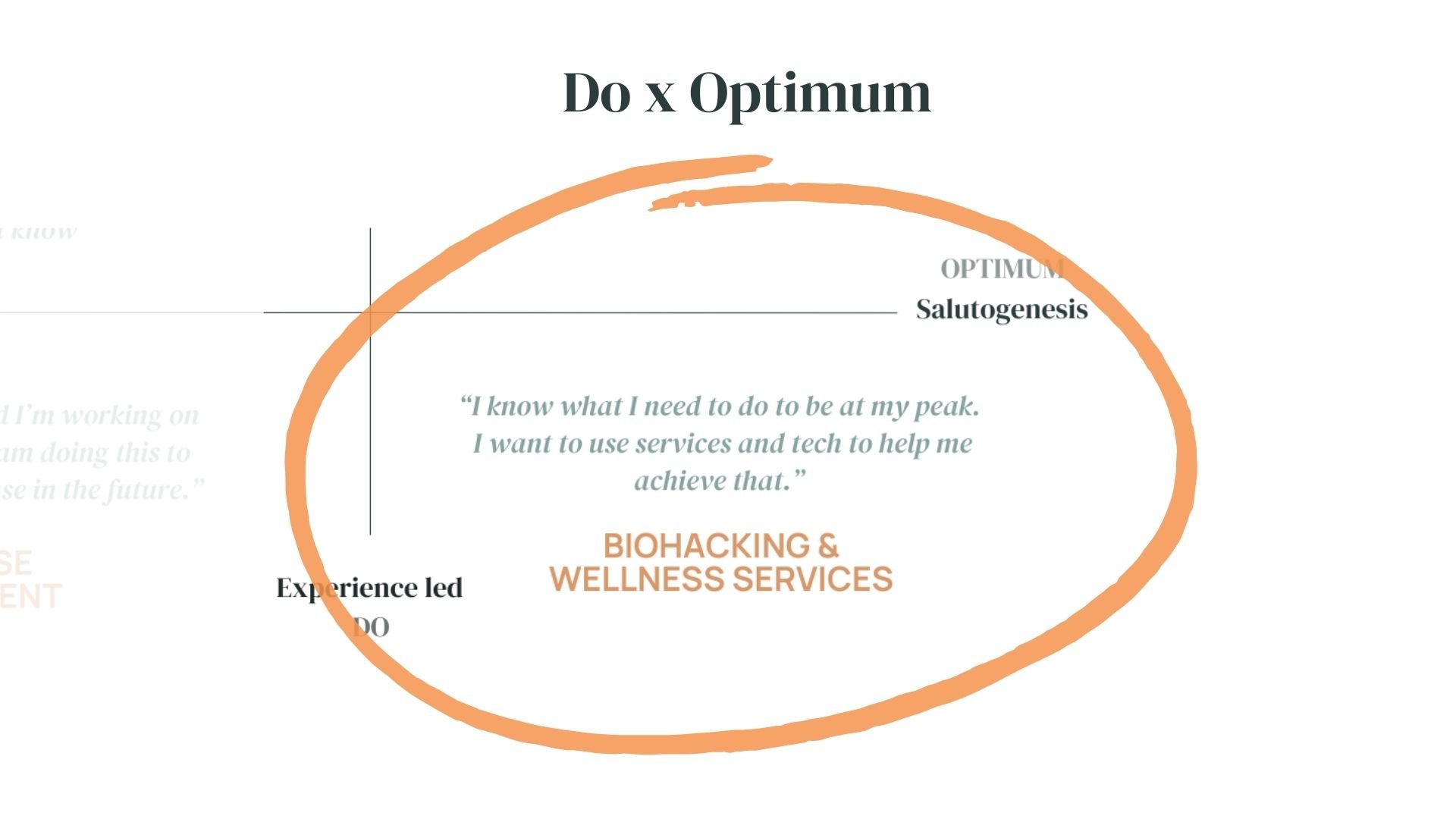
Services may include:
- Altitude training centres
- IV vitamin infusion centres
- Biohacking centres with advanced equipment and technology (e.g. with hBOT or cryotherapy)
- Gyms with advanced equipment and technology (e.g. with Carol bikes)
- Spa and wellness centres (offering protocols such as breathwork, cold water immersion, mineral bathing
Please note these are just examples, and many more exist in each quadrant.
All services have a place and a problem they aim to solve for your situation based on your goals at the time.
Matching the right health optimisation service to my needs
There are three steps here:
- First, get clear on your situation
- Then get clear on your goals
- Then be ready to ask the right questions
Step 1: What is my current health situation?
In short, are you sick, in the middle, or going great? You can consider this question against the illness wellness continuum created by Dr. John Travis in 1972 :
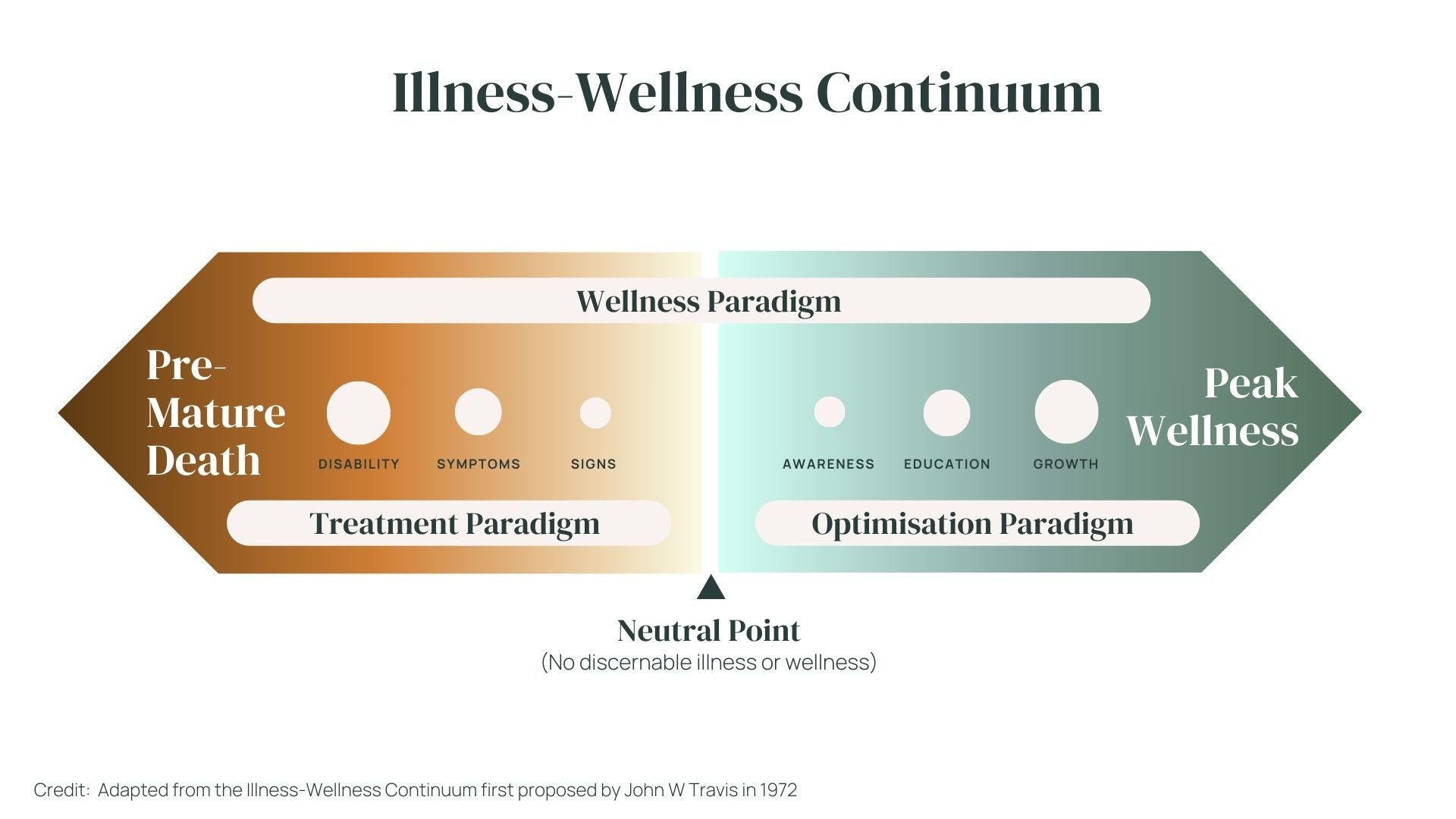
Step 2: What are my health and longevity goals?
When it comes to strategic health optimisation services, let’s be clear on three broad and distinct goals that we see in our clinic.
Goal 1: I want to avoid ‘x’ disease that runs in my family (Avoid being sick)
Goal 2: I want to live as long as I can, as well as I can (Healthspan and longevity)
Goal 3: I want to be optimum now (Daily performance)
Of course everyone’s ‘why’ is nuanced, and goals can of course be a combination of the above. But in saying that, your job is now to rank the three goals above from your strongest to weakest motivator.
Now, use the information you have gathered about yourself from the first two stages (you are either currently sick, neutral or very well and either motivated by disease avoidance, future longevity or health optimisation NOW).
Look back over the Health Services Matrix again and mark yourself in the quadrant that fits best for you.

Great, now you can narrow your search. Go ahead and find a handful of services in your area that can meet your needs. Then let’s move to the third and final step in choosing the right health optimisation service for you.
Step 3: What questions should I ask to ensure this service is a match for me?
If you are in the bottom half of the matrix, geographic proximity is likely the most critical factor – is it available near me, can I get there, is it convenient? Somewhat easy.
If you are in the top half of the matrix, oftentimes you can throw the geographical net a little wider, sometimes at a state, country or even global level. Usually the top left quadrant (SICK-KNOW) would be a little closer to home so you can make the most of insurances and government rebates.
If you are in the top right half of the matrix, you may have noticed that these services are often yet to be included in government rebate schemes or insurance policies so you generally have more choice because the geographical limitations lift. But with that, opens up more critique required to spend your private dollars wisely.
Here are my top 10 questions I would seek to answer before engaging a health optimisation or longevity strategy-based service provider (OPTIMISE x KNOW)
-
Do I want to work with a computer or a human?
-
What aspect of health does this clinic base itself upon, and does it fit with my beliefs around health (i.e. Chinese medicine, allopathic medicine, naturopathic medicine, functional medicine, integrative medicine etc.)
-
Am I wanting physical, emotional or mental well-being and as such, what does the clinic focus on?
-
At what level of the body does the clinic focus on? Organ level (e.g. brain, heart, gut), system level (e.g. cardiovascular, digestion, immune), cellular level (e.g. cell biochemistry and mitochondrial health) or even at a genetic level (e.g. DNA and epigenetics)? (Some clinics are highly specialised, some can be broader and focus on more than one level)
-
How long has the clinic been operating, and what level of trust could I give them?
-
Who would I be working with, and what are their qualifications, philosophies and level of experience?
-
Does the ethos and values of the clinic match mine?
-
Can they help me in the long term?
-
What exactly is included in the service offering?
-
What is my role in making the most of this service? (Time, money, effort and commitment – and does it match what I am willing to exchange?)
Many of these questions can likely be answered by doing good due diligence with your online research. Many others you could inquire about prior to booking, and some will become more apparent in the moment, in your first interactions.
Want to talk to us to see if we are a fit? Book a discovery call to find out how the team at Melbourne Functional Medicine can help you.
Whatever you are looking for, you are incredibly lucky. We live in a moment in time where longevity science is colliding with new offerings on the market. It is now not so much a problem of finding a service, it is finding the right service for you.
Happy hunting!
